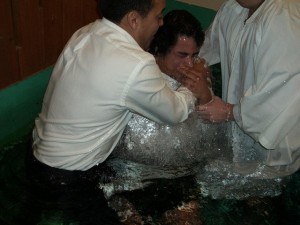By Mark Clifton

Ivan Montenegro (left), church planter of Community Baptist Church’s Spanish-language congregation in Bellingham, Wash., baptizes a new member. Members of Community Baptist worked to meet the growing needs of the surrounding city that is increasingly Hispanic by helping Montenegro plant a church, rather than closing their doors.
Photo courtesy Community Baptist Church
Legacy church planting isn’t limited to churches at the very end of their lives. Many churches find themselves with buildings far larger than they need even as they struggle to impact their immediate community in a meaningful way. They love Jesus and the gospel. They love lost people, but they can’t seem to crack the missional code of the people who live around them. They aren’t ready emotionally to turn over their ministry to another entity. But they live daily with the reality of a building that is far too big and a community that seems unresponsive. Sound familiar? Keep reading.
God has raised up an entire generation of bold, gospel-focused young men who are planting Bible-believing, community-transforming and disciple-making churches all across North America. Almost 1,000 new Southern Baptist churches launch each year. One of the single greatest challenges for these new churches is finding a location in which to meet and from which to conduct ministry.
There are tens of thousands of SBC church buildings in neighborhoods throughout cities, towns and villages around the continent. At the same time there are tens of thousands of SBC churches that are praying for their cities, towns and neighborhoods to be reached. Maybe God wants to use a new church plant as the impact point to reach that community and to use part of your church building from which to launch that new church.
The new church could lead the way in pushing back the lostness of the community and the older established church can provide a building and a base of love, care and, most importantly, strategic and constant prayer. This model of legacy church planting is happening all across North America.
Community Baptist Church in Bellingham, Wash., is one such example. After decades of effective ministry, the church stopped growing and spiraled down in decline. In frustration they even considered closing the doors. Instead the church did something courageous. Noticing a need to reach Spanish speakers in the community, they invited church planter Ivan Montenegro to plant a Spanish-language church from their building.
At first Montenegro wasn’t sure if the timing was right. But God soon confirmed the timing through a man Montenegro met named Bautista—which is Spanish for Baptist. Ivan told the man he was considering starting a church in the community and asked him if he’d be interested in helping.
After the man answered affirmatively, he returned to the hotel where he worked and invited all the Spanish speakers he knew to the potential church. That became the foundation of a new church to be hosted at Community Baptist. The Spanish-language church plant thrived from the beginning. Where the community once saw a struggling congregation, it now saw a place full of life and new people.
Another church, Armour Heights Baptist Church in Kansas City, Mo., had struggled to reach the community and experienced few results—much like Community Baptist. Their building was large enough to house several churches so they opened it up to share with an SBC church plant. The two churches worked together on children and youth ministry and Vacation Bible School. In short order Armour Heights gained a new vision, and they too began to grow!
Sometimes, as the Holy Spirit leads, the new church and the older church may become one. Sometimes the older church may hand over its facility to the new church at a later date. Sometimes the two continue to serve side by side. They may even add a third! That old building that seemed too big for the declining church can once again be filled with Great Commission activity for God’s glory and your joy!
You don’t need a multi-million dollar budget or a large staff to become a supporting church to a new church plant. You simply need to practice that old-fashioned Christian virtue of hospitality. Connect with a church planter who has the gifting and calling to plant a church among an underserved segment of your community. Come alongside of him and the new congregation. Do joint ministry in the community. Start a new church together.
In one sense you’ll become a supporting church without ever leaving your building.
It just might be the most important legacy your church will ever leave your community.
Mark Clifton serves as the national legacy church strategist at the North American Mission Board. For more information about legacy church planting options, visit http://www.namb.net/





